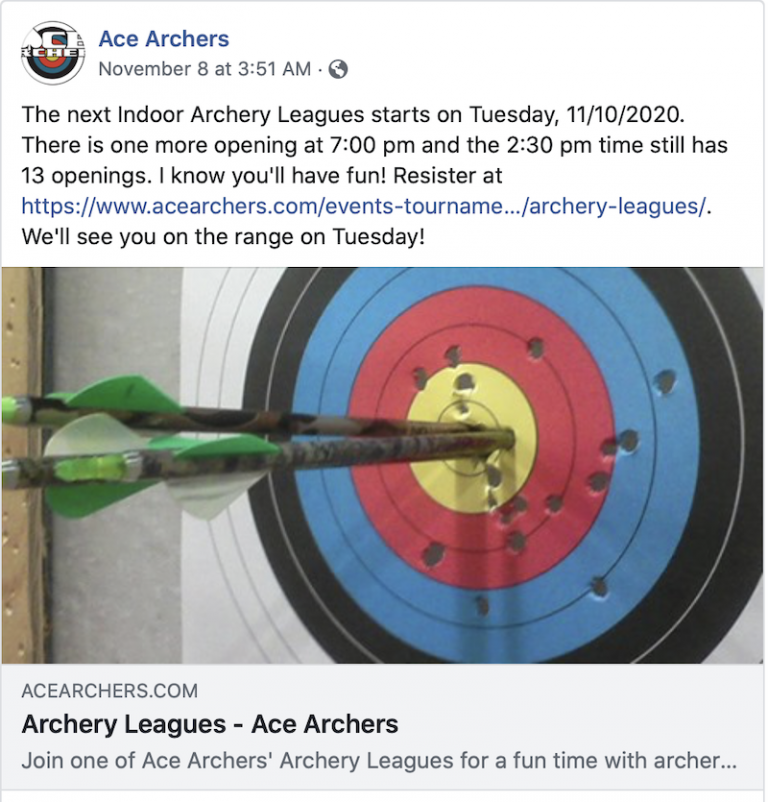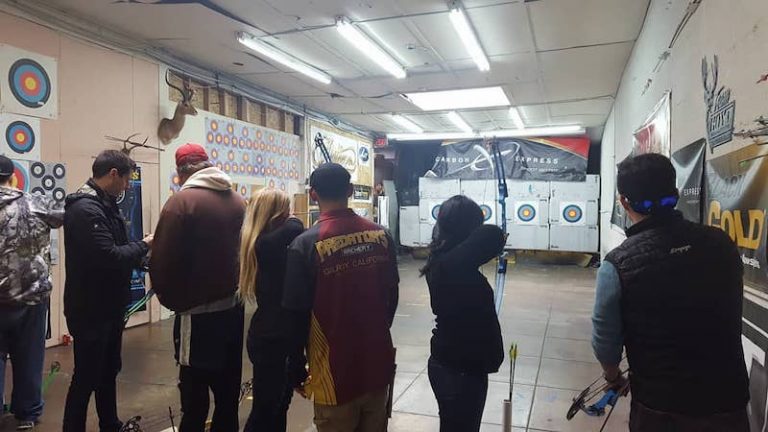Retail
Winter Leagues Boost Profits by Attracting Customers
Get the scoop on what winter archery leagues look like, and why you should offer one this year.
Photo Credit: Ace Archers
Cold weather pushes archers to indoor shooting ranges and leagues. Does your shop offer a winter league for these year-round archers?
We spoke with two ATA-member retailers who have long offered winter leagues to learn their tips and strategies for hosting fun, sustainable, revenue-generating recreation.
Curtis Campisi and Mike Pierce have owned Predator’s Archery in Gilroy, California, since 1993. They offer winter and spring leagues.
Thomas and Kathleen Herrington have owned Ace Archers in Foxborough, Massachusetts, since 2008. They started offering leagues three months after opening. They now host annual leagues year-round.

Host leagues while following any COVID-19 protocols in your area. Photo Credit: Ace Archers
Archery leagues deliver many benefits. Participants get to use their equipment regularly while improving their skills and making more friends. Leagues are great for beginners, intermediate and advanced archers. They also help retailers sell more range time and equipment while connecting with customers.
“(We) make sure league members have fun,” Thomas Herrington said. “(The league) helps people build camaraderie and competitiveness.
Campisi agrees. “Our leagues provide a social activity, as well as a place to practice and compete,” he said. “Leagues also build an archery shop’s credibility. New and potential archers have more confidence in the shop if it’s alive and busy.”
Both owners consider winter leagues their most important league because of their timing. Hunting season is often over, indoor target season is starting, and it’s often too cold to shoot outside. Archers also want to get out of the house and exercise.
Campisi said winter leagues are profitable, generating enough money to pay two months’ rent. Herrington said he makes the most money from the winter league, and that it provides reliable income. Let’s review how these shops run their leagues.

Advertise on social media and at your range. Photo Credit: Ace Archers
- Dates: Consider holidays, school breaks, vacation periods and tournament seasons when planning dates. Herrington said Ace Archers’ leagues last 12 weeks. The first two weeks establish an average score, and rounds 1 and 2 last four weeks each. Next they hold finals for one week, with the first- and second-place teams in Round 1 competing against the first- and second-place teams in Round 2. The week features the honors and awards banquet. Campisi with Predator’s Archery usually runs a 12- to 14-week league.
- League expenses: Herrington said shops must know their league expenses before setting entry costs.He gives each archer a new target face each week, and counts his range fees and time. He prints weekly stats, scorecards and league standings. He dedicates “league night” for members, but opens his range to nonparticipants if he has room.
- Participation fee/cost: Campisi charges a $40 entry fee, which covers the awards dinner, and $10 each night they shoot, for a $160 to $180 total. He also offers a discount if participants pay the entrance fee and nightly fees upfront. Herrington charges a $14 entry fee to offset the banquet costs ,and $14 per night to shoot, for $182 total.
- Shooting times: Campisi said evening leagues work best. They offer three nights weekly for archers to shoot their scores. Herrington lets people shoot on Tuesday afternoons and evenings. He said retirees and people who can’t drive at night often attend the afternoon session. The finals and banquet are held Tuesday evening.
- Number of participants: Campisi said Predator’s Archery averages about 20 archers per league, and they can accommodate 18 per night. Herrington said Ace Archers has 10 to 28 participants in each league. He splits competitors into teams of two, three or four. Herrington pairs archers so all teams have a similar “team average.” He also honors requests to team with or against other members. Both shops get repeat and new participants. They encourage archers to sign up early to ensure their spot. Campisi also built a second range to accommodate more archers.
- Categories: Depending on the participants’ interests, both shops organize them into different classes. Those factors include age and competitive level, such as “fun” or “serious.” Others are separated by equipment, such as an open league for any bow, or a barebow league for those who don’t use sights and stabilizers.
- Handicap scoring: Both shops use a handicap scoring system to even the competition between beginners and advanced archers. For example, if Team 1 averages 100 points per game and Team 2 averages 80 points per game, Ace Archers gives the lower average team an 80% bump on the difference. Because the difference is 20 points, Team 2 gets a handicap of 16 points (80% of 20 points is 16). Herrington calculates each team’s average score every two weeks, and adjusts a handicap to ensure shooters aren’t “sandbagging.”
- Advertising: Promote your winter league in advance, but remind them why they should join. That is, it’s fun, they can improve their skills, and they can meet people. Advertise the league inside and outside your shop. Hang flyers in your range, at your checkout counter, and at libraries, schools and businesses. Post about the league on social media and your website. Also, personally invite customers to join. Herrington said people more often join when personally invited. He also sells upcoming leagues during the finals of current leagues. Campisi starts advertising and taking sign-ups two months before the league starts.
- Waivers and releases: Herrington makes participants sign a “Data Application and Release” form from his lawyer. This signed document secures the participants’ contact information while releasing the Massachusetts shop from liability, should an accident occur. Liability waivers don’t hold up in California courts so Campisi and the Predator’s Archery team don’t use them. Herrington also asks customers to sign a photo-release form, which gives his team permission to post customer pictures online.
- Banquet and awards: Both shops host a banquet and awards night to conclude the league. They said awards motivate and inspire participants. Plus, the banquet is a fun way to celebrate the league. Campisi honors the first-, second- and third-place archers, and hands out a “most improved” and “X-master” award. Herrington presents awards to the first-, second- and third-place teams, as well as a “most improved” award. Campisi holds the dinner at a restaurant. Herrington holds the Ace Archers banquet at his shop, but canceled recent banquets because of COVID-19.

Start with one league for all bow types until you gather traction, then expand. Photo Credit: Predators Archery
1. Start Small, but Just Start
“Try just one league (to start), perhaps an open league, which allows all bow types,” Herrington said. Once you have a league or two under your belt, add a barebow league or a youth league. Youth leagues, of course, require more effort and attention.
2. Find a League Organizer
“We always wanted to offer a league, but it can be time-consuming and inconvenient for smaller shops,” Campisi said. “The solution is to find a dedicated archer who will actually run the league. In return, they get to shoot the league for free. Sometimes two people share the responsibility. This allows shop staff to focus on sales and service.”
3. Learn from Your Mistakes
“You will make them,” Herrington said. “Be up front with your error, address it, and make sure the league members still support you.”
4. Leagues Don’t Have to be Fancy
“People just want a place to shoot and practice,” Campisi said. “Archers spend a lot of money on equipment. Leagues give them a reason to use their equipment all year. Every archer needs to practice. Leagues allow archers to practice, and shops to make money off their practice.”
The ATA has tools to make planning and organizing a league easy.
Log into your MyATA member dashboard and click “Download Free ATA Resources” to access the ATA’s Resource Website. Then, enter “league” in the search bar to find the “Introduction to Leagues: 1 Hour Outline.” The document explains how to teach a class that reviews common league formats, strategies and scoring techniques. The class builds confidence in customers so they commit to a league.
Also use the ATA’s Event Planning Workbook to craft and organize your league and other events. The workbook simplifies planning, and provides tips and insights for making decisions. Click here to learn more. To download the Event Planning Workbook, log into your MyATA member dashboard and click “Download Free ATA Resources.” Search for “Event Planning Workbook,” print the pages, and add them to a three-ring binder.
To ask questions or get more information, please contact Nicole Nash, ATA’s range and retail-programs manager, at (502) 640-0944 or nicolenash@archerytrade.org.

WE ARE HERE TO HELP THE INDUSTRY, TO HELP INDIVIDUAL BUSINESSES GET THE MOST OUT OF THE INDUSTRY, AND TO HELP YOU.